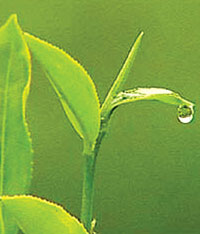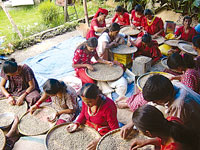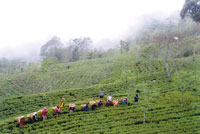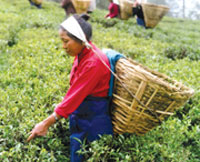 Mount a crest in the carpeted green slopes of the Kanyam Tea Estate and you will be atop 'Shooting Hill'. It is so named because of the countless Nepali film song and dance sequences and music videos that have been shot here. When there is no one shooting, picnickers flock the area to romp and sing their favourite movie songs.
Mount a crest in the carpeted green slopes of the Kanyam Tea Estate and you will be atop 'Shooting Hill'. It is so named because of the countless Nepali film song and dance sequences and music videos that have been shot here. When there is no one shooting, picnickers flock the area to romp and sing their favourite movie songs.
From up here at 5,500ft you can see the entire Ilam region, even Darjeeling and Kurseong across the border. The cool climate, emerald greenery and the songs of the tea pickers all blend to produce a particular Nepali tea culture, one that growers think is ripe for tourism.
"This is proof that even the gardens can pull people," says Punya Dhakal, manager of Kanyam, one of the area's largest growers of orthodox tea, and a fervent believer that tea tourism" has a great future here.
Known for ginger, milk, jute, potato and its blistering hot chilli eastern Nepal's Ilam, Panchthar, Dhankuta, Tehrathum and Sankhuwasabha has now added tea to its list of assets. Eighty percent of tea grown in Nepal today comes from Ilam.  Most of the gardens are less than 15 years old and the leaves are hand-picked from young bushes that have two leaves a bud, growing at 3,000-7,300ft.
Most of the gardens are less than 15 years old and the leaves are hand-picked from young bushes that have two leaves a bud, growing at 3,000-7,300ft.
All of this produces a unique blend for tasters and tourists alike. "Our tea is virgin, free of pesticide. The weather is very similar to Darjeeling and the culture of this region is equally unique."
The geographically distinct eastern hills form the only hill region in Nepal whose weather is right for growing tea. And they are well situated for those who wish to escape the heat of the tarai. "We have seen a lot of potential for internal as well as international tourism promotion here as there is direct contact with nature and the warm hospitality within the gardens to add to it," says Uday Chapagain, chairman of Himal Tea Producers Cooperative. Tea growers here say tourists will not just enjoy themselves but also warm up to the art of producing tea-from picking, plucking and tipping, through withering, rolling, fermenting, drying and sorting and finally to tea tasting, all the while learning about the lives and cultures of the growers and pickers.
|
|
"French and Japanese visitors come to us every year. They live in the staff quarters, roam the gardens, drink tea and return with a most wonderful experience," says KC.
It will take time before Ilam catches up with Darjeeling which has a head start in mixing tea with tourism. But importers from Germany, Japan and the US have started showing interest. Nepal could also get visitors from Darjeeling when the Pashupatinagar checkpoint has an immigration office.
Tourists can also choose to visit the CTC (Cut Tear and Curl) tea gardens in Jhapa and then journey to breathe the fresh mountain air in the Guranse Tea Estate in Dhankuta which at 7,300ft is the highest garden in Nepal.
While Darjeeling produces 10 million kg of premium tea a year, Nepal's annual yield is about 1.6 million kg. Ninety-three percent of the orthodox tea grown in Dhankuta and Ilam is exported. Annual world demand is about 50 million kg and Nepali orthodox tea is now making a mark in the Japan, Germany and US markets. Guranse Tea Estate has already earned a ISO 9001-2000n certificate.
Experts say that if properly marketed Nepal can sell as much premium tea as it can produce, and they think promoting tea tourism is a good way to market Nepali tea. Some of the estates are now developing hotels and lodges inside the gardens like in Sri Lanka and Indonesia. Visitors there can roam the hills at their leisure and return with various flavours of tea as souvenirs. Guranse's manager Santosh KC is optimistic: "If we create the proper atmosphere, we can make five Darjeelings in Dhankuta and attract buyers and tourists at the same time."
With help from Helvetas  The Swiss aid agency Helvetas has also been helping Nepal with training of Nepali coffee farmers, setting up demonstration farms, marketing campaigns in Europe and elsewhere as well as training in processing of beans.
The Swiss aid agency Helvetas has also been helping Nepal with training of Nepali coffee farmers, setting up demonstration farms, marketing campaigns in Europe and elsewhere as well as training in processing of beans.
But experts say a lot more needs to be done to promote Nepali coffee. The 'Nepal' brand may not yet be very well known for coffee, but it is gaining recognition among connoisseurs for its organic content. In addition, Nepal could benefit from 'Fair Trade' and 'Organic' labels in Europe and the United States if consumers there know that the coffee they drink directly benefits farmers in the Himalaya and protects the environment.
Coffee farming is attractive to farmers because the beans fetch a good price and also because it can grow in combination with fruit trees and other crops. The other challenge is to convince domestic consumers to switch from imported refined instant coffee to Nepali-grown beans. In 2005, 34 tons of coffee (about one-third of the total production) was consumed within Nepal. This demand grows and falls with the number of tourist arrivals-indicating that it is mostly foreigners in Nepal who drink the stuff.
However, all this may be changing as the Nepali taste for coffee gets more sophisticated and new cafes serving brewed coffee spring up in Kathmandu and other cities.
|
|
Nepali tea growers have realised that they need to create a create a brand image in the global market and have united under the slogan: 'Nepal Tea: Quality from the Himalayas'.
For this, they have enlisted the support of famous mountaineers. Tyrolean climber and former member of the European Parliament, Reinhold Messner, who has climbed all eight peaks in Nepal above 8,000m, is Nepal's tea brand ambassador. Guranse Tea Estates has named Jamling Tenzing Norgay, Brent Bishop (son of American climber Barry C Bishop) and Peter Hillary (son of Sir Ed) as 'brand promoters'.
Groups associated with the Nepal Tea Alliance are also uniting to promote the brand and boost exports, leading to today's price of Rs 10,000 per kg for Nepali premium tea. The Private Sector Program under German development agency GTZ is also playing a major role in promoting Nepali orthodox tea internationally.
"German investors are keen to visit Nepali gardens and more than a dozen of them will be visiting Ilam this October to examine the potential of Nepali tea. "They are not only interested in tea tourism but also want to provide cutting edge facilities to Ilam's old gardens," says Arun Rana, a consultant for GTZ/PSP, "If our tea growers can also focus on the international code of conduct for tea production Nepali tea has limitless potential."




